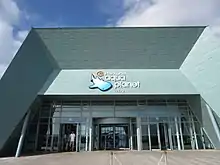Aqua Planet Jeju
Hanwha Aqua Planet Jeju (아쿠아 플라넷 제주) is an aquarium that opened in 2012 in the Jeju Province, South Korea. It is an aquarium operated by Aqua Planet and is the largest public aquarium in South Korea.[1]
| Aqua Planet Jeju | |
|---|---|
 Entrance | |
| 33.4328°N 126.9278°E | |
| Date opened | 2012[1] |
| Location | Jeju Province, South Korea |
| Floor space | 25,600 m2 (276,000 sq ft)[1] |
| No. of animals | 48,000[1] |
| No. of species | 500[1] |
| Volume of largest tank | 5,300 m3 (1,400,000 US gal)[1] |
| Total volume of tanks | 10,800 m3 (2,900,000 US gal)[1] |
| Management | Hanwha Group |
| Website | www |
Exhibits

Aqua Planet Jeju, It consists of three marine-themed halls, consisting of an "ocean arena" (performance hall) and a "marine science" (science museum) and "aquarium".[2] The main tank, The Sea of Jeju, has a water volume of 5,300 m3 (1,400,000 US gal) and is the largest tank in South Korea.[3] Large sharks and rays such as Sand Tiger and Giant guitarfish are bred in the aquarium. There is also a tunnel inside the aquarium.[2] The main creatures are penguins, seals, sea lions, walruses, arapaima gigas, sand tiger sharks, giant groupers.[2]
In addition, the public aquarium carries out regular beach cleaning and underwater purification work, and has established South Korea's first specialized medical center for marine life, and is engaged in many activities for the conservation of marine life.[4] In addition, Aqua Planet Jeju has educational programs such as a diving experience program in the main tank and an ecological briefing session for otters and penguins.[5]
Aqua Planet Jeju has started a special exhibition of Minions for about a year from July 31, 2020.[6]
Shows
The aquarium has a large dolphin and walrus show. Many shows are held in Ocean arena and are hosted by the Eastern European Synchronized Swimming Team. [3]
Controversies
Initially, two whale sharks and one manta ray were captivity in the main tank. However, it received a lot of criticism from animal rights groups because one whale shark and one manta ray died.[7] An official at Aqua Planet Jeju explained that "the cause of death of fish is chronic renal failure and there is no cure", but public opinion moved to release the remaining whale shark, so it was tagged and released.[8][9]
See also
Notes
- "한화 아쿠아플라넷 제주, 바닷속 친구들 다 모였네". 중앙일보. Retrieved 2021-05-28.
- "Hanwha Aqua Planet Jeju". hanwha resort. Retrieved 2021-05-28.
- "Guide Map". Aqua Planet Jeju. Retrieved 2021-05-28.
- "보호대상해양생물이란?". Retrieved 2021-05-27.
- "아쿠아플라넷 제주의 진행중인 프로그램과 일정을 알려 드립니다". Retrieved 2021-05-27.
- "미니언즈 제주 특별전". Retrieved 2021-05-27.
- "고래상어 죽은 수족관서 쥐가오리도 폐사". Retrieved 2021-05-27.
- "아쿠아플라넷, 고래상어 생태연구를 위해 방사 결정". Retrieved 2021-05-27.
- "고래상어'파랑'이 31일 바다로 돌아간다". Retrieved 2021-05-27.